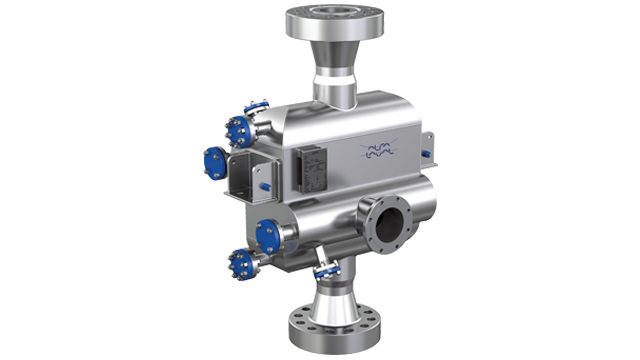Printed circuit heat exchangers
Trust the results from 15 years of proven performance. Alfa Laval printed circuit heat exchangers (PCHEs) combine superior robustness and integrity with an exceptionally high heat transfer rate, in a unit that’s up to 85 % smaller and lighter than comparable shell-and-tube and shell-and-coil exchangers. The unique design results in excellent performance, lower installation and operational costs, as well as improved safety. Each unit is also fully customizable according to your exact needs.
First-class efficiency with the smallest possible footprint
- All-stainless-steel design, available in standard configurations or fully customized
- Robust design handles pressures up to 1,250 bar (18,125 psi) and temperatures ranging from -196°C (-320°F) to 800°C (1472°F)
- Immune to fluid pressure pulsations and fluid-flow-induced vibration, which can cause fatigue failures
- Fully compliant with ASME Boiler & Pressure Vessel Code (Section VIII, Division 1 with U Certification Mark) and CE Marking (as per PED 2014/68/EU)
- Conformance with ISO 19880 and SAE J2601 for hydrogen refuelling dispensers.
Alfa Laval printed circuit heat exchangers are an ultra-compact solution for improving sustainability in marine, oil & gas, thermal and renewable power applications (such as thermal energy storage systems, supercritical CO2 power cycles, gas turbine fuel gas pre-heating and hydrogen refuelling stations, etc.).
Photo-chemically etched fluid micro-channels provide exceptionally high thermal performance, while state-of-the-art diffusion welding (bonding) produces a solid core packed with heat transfer area.
The combined result is maximum efficiency and minimum footprint, ensuring the lowest total lifecycle cost.
Applications
Alfa Laval printed circuit heat exchangers are designed specifically to deliver unparalleled compactness and efficiency in clean and high-pressure duties that are beyond the capability of other welded plate type heat exchangers. The robust design can reliably handle pressures ranging from full vacuum to 1,250 bar (18,125 psi).
Typical marine applications include high-pressure vaporization in fuel gas supply systems (FGSS), LNG regasification on FSRU and SRV™ vessels. In the energy sector, printed circuit exchangers are used in gas processing and cryogenic LNG applications. Typically, these are gas compression systems offshore, hydrocarbon gas and water dew-pointing. In LNG, where high energy recovery is desired, they are used in End Flash Gas and BOG handling systems. They can also be found in turbine fuel gas preheating and supercritical carbon dioxide (sCO2) applications for power generation.
In renewable energy applications PCHEs are proving to be a great technology fit in high-temperature long duration energy storage (LDES) processes, as well as evolving niche positions in carbon capture.
Combining the proven advantages of our classic PCHE design with our 3DPlate™ anti-freezing technology also opens up use across the whole hydrogen refuelling station energy chain from liquid to gas. In hydrogen refuelling stations, Alfa Laval PCHEs are an ideal solution for precooling of hydrogen, offering possibilities to reduce filling times and wait times between refuels, while minimizing installation costs.
Technical data
Design pressure
EN/CE/PED Vacuum to 1,250 barg (18,125 psig)
ASME Vacuum to 1,250 barg (18,125 psig)
Design temperature
316/316L SST –196°C (cryogenic) to 800 °C (–321°F to 1,472 °F)
Connections
Customizable from small tube to large pipes (¼ to 30)
Standard materials
304L or 316L SST (other materials available on request)
Dimensions/Weights
On request, tailored towards requirements ranging from a few kilograms to tens of tons
工作原理
Working principle
Printed circuit heat exchangers operate with two or more media on opposite sides of a diffusion welded plate. It is possible to have high-pressure flows on both sides, and a 2D or 3D plate pattern can be optimized to provide the required thermal length and pressure drop.
Design
The printed circuit heat exchanger design has a complex flow pattern chemically etched on flat sheets of material. This flow pattern is optimized for each specific customer duty to provide the required thermal and hydraulic characteristics. Each flow circuit plate pattern can be different, giving the possibility of asymmetric flows and optimized 2-phase behaviour.
The individual plates are then stacked into a block and diffusion welded (bonded) in a state-of-the art furnace at high temperature and pressure. Multiple blocks can be welded together to create the required thermal capacity or heat transfer area. Inlet and outlet flow manifolds, customer connections and (if required) connections for drain, vent or cleaning form the welded header assemblies, which are welded onto the completed core to finalize the heat exchanger.
Design pressures of up to 1,250 bar (18,125 psi) in 304/316 stainless steel are achievable with this configuration.
Heat transfer surface areas are tailored based on requirements.
Unique features that make the difference
Alfa Laval has more than 80 years’ experience in heat transfer technology, and we are continuously developing new innovations to improve the performance, reliability and sustainable impact of our equipment. Our printed circuit heat exchangers include a number of unique features you won’t find anywhere else.
Alfa Laval energy news on LinkedIn
Stay tuned to our Energy LinkedIn page for the latest news on our solutions.

Alfa Laval marine news on LinkedIn
Our showcase page with the marine solutions you need to stay ahead.

Save your energy – from start to finish!
Benefit from Alfa Laval’s decades of experience of working with EPC projects and your end customers. We can support you throughout the project to make sure your customers get the optimal heat exchanger package.

邁向永續的技術對策
想像一個更加永續的世界:一個以更少資源,創造更多價值的世界;在這裡,我們高效滿足日益增長的能源需求,並同時減少碳排放。 想像一個世界,我們在利用自然資源的同時,也守護著它們;在Alfa Laval,我們與客戶和夥伴正共同建構這個理想的世界。





